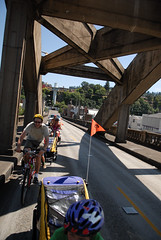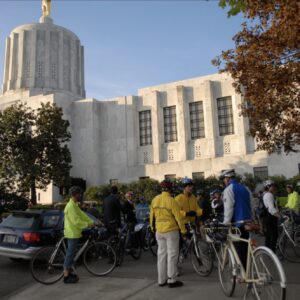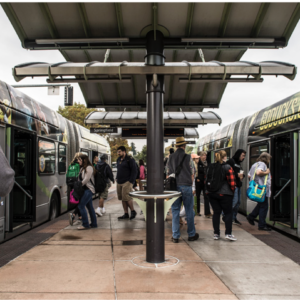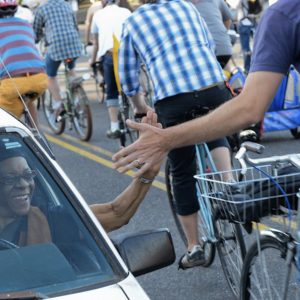As we reported back in April, the Oregon Department of Transportation (ODOT) is planning to close the historic Oregon City/West Linn Arch Bridge for two years during a major rehabilitation project.
The problem with the project is that there has not yet emerged a solution for how to detour non-motorized traffic. Cars and trucks can zip around the project and use I-205 to the north, but bicycles and pedestrians are not allowed on that stretch of highway. The closest crossings for bikes and pedestrians would be the Sellwood Bridge (six miles north) or the Canby Ferry (nine miles south) — making neither of them viable options.
ODOT’s Region 1 Manager Jason Tell, told me on the phone this morning that trying to figure out a solution has been “extremely difficult and challenging.”
That’s why ODOT will lead a tour of the project area with local elected officials, experts, and advocates tomorrow.
Confirmed for the tour are the mayors of both West Linn and Oregon City. Clackamas County Chair Lynn Peterson, the executive director of the Oregon City business association, ODOT engineers and project managers, Michelle Poyourow with the Bicycle Transportation Alliance (BTA), and others.
Poyourow says the BTA is “much more than concerned” about the impending closure, but as of today, ODOT says they’re still at a loss for how to make it happen.
“Whatever we have to make sure we won’t add more time to the closure. If we build some type of bridge for bikes and pedestrians, we have to ask, will it be safe and will it be something the contractor can work around?”
— Christine Miles, ODOT
ODOT spokesperson Christine Miles said many proposed solutions simply don’t pan out. Ferries would be difficult, she says, because of the extremely steep cliffs below the towns on each side. Even if a path could be built, making it ADA compliant would present challenges. Miles also told BikePortland this morning that the bridge is narrow (about 28-feet wide) and that the equipment to be used during the project is large — meaning no room would exist for a bike/ped pathway on the bridge during the project.
Miles repeatedly expressed that their main concern for any bike/ped access solution is safety, and that all options are on the table. “We’re taking a serious look at every option right now.”

(Photo: Wikipedia)
Keeping a path open for non-motorized access during the project was initially in the plans from ODOT, but after looking at it more closely, they now see no way that can happen. They acknowledge that a two-year closure would be a major pain for people that use bicycles or their feet to get from West Linn to Oregon City (or vice versa) and they have also heard from local business owners that it would severely impact their business.
The bridge was closed for three weeks during some utility work back in May. We spoke to businesses in downtown Oregon City and they reported a drop in business of 50%. The prospect of the longer closure is making many of them very nervous.
Miles said ODOT is having regular meetings with business owners to help deal with concerns, but Francesca Maimone, owner of Avanti Salon in Oregon City, says the meetings have not been helpful (she described them as “kind of like a joke” and “really frustrating”).
Maimone said her business depends on traffic coming on and off the bridge. Absent of motor vehicle traffic, she said she hopes some level of travel can be retained during the project. “It’s possible to do something to keep it open. I think it’s important for bikes and pedestrians who depend on that bridge to come across.”
One idea that has been put forward is to build a separate, cantilevered bike and pedestrian crossing off the bridge that could be used during construction. (The Oregon Bicycle and Pedestrian Advisory Committee has sent a letter to ODOT with that recommendation, but I have not seen the letter yet.) When asked about that idea, Miles said that besides safety concerns, ODOT has to make sure that any new pathway that is built doesn’t add more time to the closure. “Whatever we have to make sure we won’t add more time to the closure. If we build some type of bridge for bikes and pedestrians, we have to ask, will it be safe and will it be something the contractor can work around?”
Miles said tomorrow’s tour is ODOT’s attempt to have local leaders understand the challenges they face. She also said she hopes to glean some expertise from the BTA. “We want to show that we’re serious about finding a solution and we need their help in finding one.”
ODOT regional manager Jason Tell echoed that statement, saying “We’re throwing a lot at this to try and figure it out… and we want to get others involved to help us solve it.”
A decision about bicycle and pedestrian access is expected to be made by the end of this year, but Miles says they’d like to make one sooner if possible. Construction on the project is slated to go from Jan 2010-2012. Learn more at ArchRehab.com.








Thanks for reading.
BikePortland has served this community with independent community journalism since 2005. We rely on subscriptions from readers like you to survive. Your financial support is vital in keeping this valuable resource alive and well.
Please subscribe today to strengthen and expand our work.
Put temporary bike/ped bridge on a couple of moored barges.
The Seattle solution during the Fremont bridge closure was to operate a shuttle van that would drive you and your bike to the other side.
It replaced a Ped Suspension bridge? Build a new one. The pictures on wikipedia looked like a few steel towers for supports. I’m sure we can find four of those.
Moored barges wont work, there is river traffic South/upstream of it. Plus with a flood stage river coming over the falls, I’d want to be a bit higher off the river.
Preferred option: Just build permanent extra bridge for peds and cycles.
Cheaper option: army style pontoon bridge that can be opened in the middle when necessary.
When I put on my “bold and visionary” hat, I think, Why not just build a new permanent bike/ped bridge?
When I put on my “cheapskate in a recession” hat, I think, Why not let bikes and pedestrians use the I-205 bridge? Install any lane striping, Jersey barriers and temporary ramp signalization required to make it safe. You might even be able to do it without losing a lane of auto traffic. (But tough tootie if not… bikes shouldn’t be the only ones bearing the burden.)
Lee (#2) – i like the shuttle concept. might add $1 mil or so cost over 2 years of construction, but the alternative scenario is essentially no bike/ped access.
The shuttle idea deserves exploration. In the SF Bay Area, there is a bike shuttle that runs across the Bay Bridge during commute times (when the BART train does not accept non-foldable bikes.) They’ve been running it for at least ten years.
http://www.dot.ca.gov/dist4/shuttle.htm
They’ve been working on this project for 5 years- and they’re going to ask local politicians for ideas??? I doubt the two mayors have much knowledge of technological advancements in engineering! ODOT has plenty of engineers to come up with a solution. The “tour” is a sham. Just to show how hard they’re “trying”. And “oh well! look, we really tried, and couldn’t come up with a solution!” Dude, get real! They could have easily, in the past 5 years, built a temporary ped/bike bridge in anticipation of their project.
The supporters of the bridge closure have turned this into a spectacle. Supporters are property owners who want the value of their properties near the bridge to increase. The “tour” is a media ploy.
I had a meeting in West Linn and totally forgot about this issue and was unsure about the timing until I neared the bridge. If it had been closed, I would have lost a potential client. Sure, it was my own [potential] error.
That link is rather important. It makes sense to rally around it. It’s *our* government after all. Isn’t it?
from personal experience, the shuttle for the fremont bridge closure sucked, and was really more trouble than it was worth. Eventually, I started taking the lane on the aurora bridge (dangerous!) because it was faster and there was less wrangling with the shuttle driver over how to get to the other side. (hint: Don’t use the ballard bridge)
So, maybe ODOT can have an effective shuttle, but heck, why not just build a bike/ped bridge along side the road bridge?
Sounds like what they did to us down here in Wilsonville. I used to commute to Aurora across Boone’s Bridge on I-5 but ODOT shut down the North bound shoulder for six weeks with no alternative route. So I can get to work, I just can’t get home.
The jersey barrier idea is great for on I-205, but when I suggested it for the I-5 issue (since the southbound shoulder is still open) I was told that it was too expensive and would shut down a shoulder for vehicles.
They have not tried that hard to find a solution.
I-205 shoulder access or a shuttle (via I-205) are both viable. Further, a ferry would not need to be adjacent to the closed bridge, where they say the cliffs are too steep. What about a mile downriver near Clackamette Park, or someplace in between?
Oh, I get it. All of these solutions don’t fix the problem of reduced traffic for the business owners near the bridge. That is the only thing ODOT truly cares about – not actually enablng cyclists and peds convenient access across the river. Both are important, definitely, but it is called the Oregon Dept of TRANSPORTATION.
From the project website,
> “Free shuttle services will be provided with schedules and routes yet to be determined. Other options are still being investigated.”
Jonathan, are they looking at finding an alternative to the shuttle they plan or something in addition to it?
I also wonder if they’re involving local politicians to find funding for a shuttle service. [If trimet serves that area, maybe trimet could offer free ‘river hopping’ for cyclists?]
Doesn’t it make you wonder – if they are finally performing a bridge rehab for an almost hundred year old bridge, shouldn’t they be widening the sidepaths?
The current bike/ped paths on the bridge don’t seem even ADA acceptable. The first step of the bridge construction should be widening the sidepaths so they can stay open during further construction and be adequate for modern bike/ped traffic levels after construction.
Peter and others.
About the shuttle.
I think what you read on the website is old. Yes, the shuttle is the idea that has been around the longest… but I think the basic feeling is that it would be inadequate. I should have asked Miles for more details on it.. .. but it seems like one shuttle would not work.. and having several shuttles would be cost prohibitive.
bottom line is that if the shuttle was the solution, they wouldn’t be still saying they’re looking for one.
Aren’t there boat ramps and docks on both sides of the river downstream from the falls? (I know there’s a boat ramp and dock at Willamette Park in Willamette, but haven’t been down there in years and don’t recall if there is a a publicly-accessible dock and ramp on the other bank upstream of the falls.)
Why can’t they run a ferry from dock to dock? Even a pontoon boat would work. More direct, too.
As if closing this bridge isn’t bad enough, the next closest crossings in either direction are less than ideal. The Sellwood Bridge is pretty frightening to cross on a bike, and the Canby Ferry, while kind of fun, is subject to random closures. I’ve cycled down there more than once, only to find the ferry not operating.
For bikes, the only real solution is to carve a path on the I-205 bridge using temporary concrete barriers. Of course, as others have stated, this will do nothing to help the local businesses concerned about reduced traffic in front of their stores. I’m not sure there is a solution for that.
As part of the I-5 Delta Park ODOT work they are selling ‘extra’ jersey barriers from the project for $50.
Perhaps ODOT can transfer these to this need or we can start a grass roots donation process to buy these barriers for the 205 work…just brainstorming here…
This seems to be an ongoing problem for ODOT [and many DOT agencies]…what to do with bike and ped traffic during its many bridge closures…’normal’ car centric detour plans are too far for bike ped traffic…perhaps they should consider not fogetting it/ fighting it as the need will not go away.
How about setting aside some budget to buy 2 mini ferries (like these in service in Amsterdam – but made locally) or temporary cantilevered bridge pathway materials that could be used on most bridges during said repairs/ closures throughout the state.
These items could also be useful as part of contingency plans for bridge distasters or terrorism…there must be some homeland security money left.
Though I think ferries ‘scare’ [as in make uncomfortable] the managers at ODOT…perhaps WSDOT can help them get over this. 😉
If they could use cement barriers, the Oregon City to West Linn crossing could work. I wouldn’t want to do it without the barriers though. There are too many people gunning it coming around the onramp corner more concerned about hitting freeway speeds than looking out for people on the shoulder. But West Linn to OC would be tougher to pull off. The offramp isn’t very wide and it is very traffic heavy.